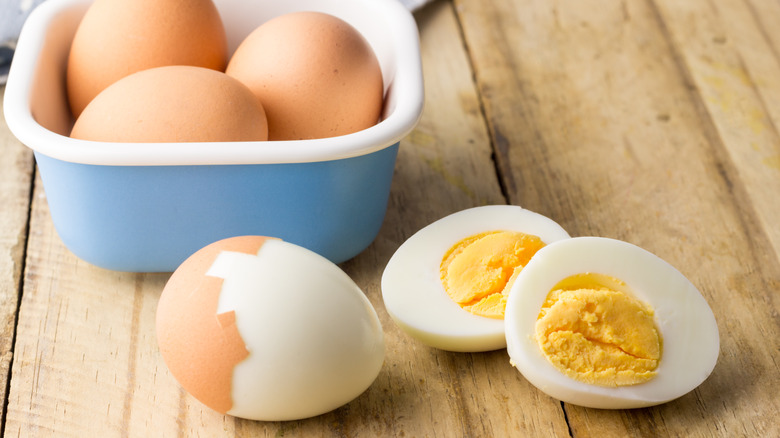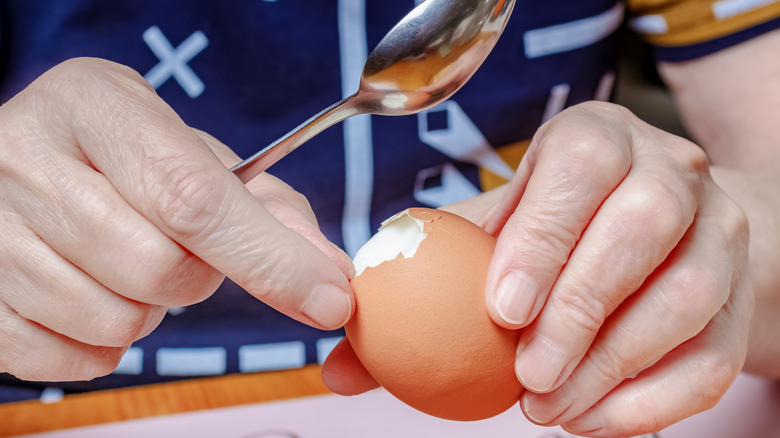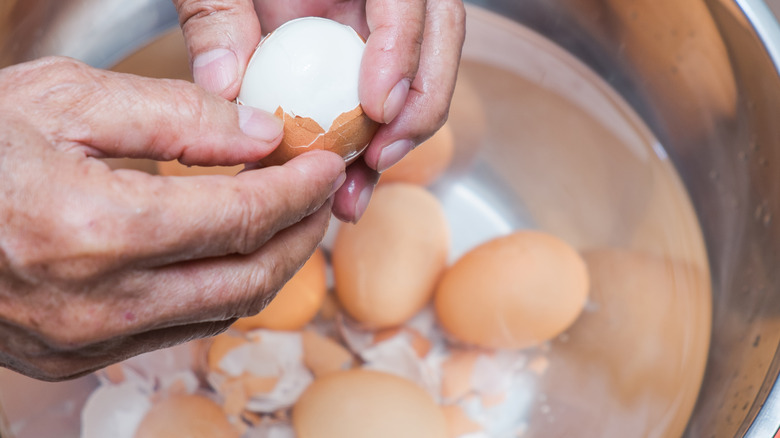Peel Hard-Boiled Eggs Under Water For Effortless Results
We've all been there. Anyone who has ever tried to make an egg salad or deviled eggs knows that the most tedious part of the entire process is peeling away the shell from hard-boiled eggs. So often the results are a mess with eggs that have broken apart or are left with unattractive cracks and gouges. While imperfections aren't a worry when the hard-boiled eggs will be chopped or mashed in a recipe, they do become an eyesore when a recipe calls for a perfectly smooth and glossy hard-boiled egg. This is the aesthetic we are looking for when preparing decadent deviled eggs for a party or when slicing hard-boiled eggs for an elegant salade niçoise.
A quick internet search will yield a plethora of tips and tricks for peeling hard-boiled eggs, from the obvious to the downright wacky. However, in the end, there is one foolproof method that will work every single time. No need for any fancy tools — all you need is water!
Why hard-boiled eggs can be a pain to peel
Hard-boiled eggs are inherently difficult to peel because there is a thin yet strong protective membrane between the egg white and the shell. This membrane is a powerful adhesive, and the goal when peeling a hard-boiled egg is to gently release that membrane, along with the shell without damaging the perfectly cooked egg white beneath it.
Some cooks swear by various techniques when it comes to loosening this membrane and removing the shells from hard-boiled eggs. The typical go-to method would be to lightly crack the shell on the countertop and gently roll it, allowing the shell to start crumbling away. While this technique is convenient, it doesn't always offer the cleanest results. Others use a spoon to try to release the shell from the egg by inserting it in an opening at the bottom and rotating it around the egg white. The hope is that it will come off in one piece, but this is rarely the result, and the possibility of dents on the egg is high.
There are even techniques that claim the key to easy peeling eggs lies in how they are boiled. These options add baking soda or even vinegar to the boiling water to help release the shell, but they are far from foolproof. Instead of loosening the bond between the shell and membrane, the acid destroys the calcium carbonate of the shell. So, instead of an easy-to-peel egg, you'll have a shell that is soft and smears as you peel it, sometimes still pulling away chunks of egg white.
Water is the key to perfectly peeled eggs
Ultimately the key to perfectly peeled eggs is quite simple — water. Using water to help release the membrane from the egg, and then taking the shell along with it, is the key to a perfectly peeled egg. Water can be used in one of two ways. After gently cracking the egg on the countertop to get it started, an egg can be peeled under the running water of your kitchen faucet. The water, along with the mild pressure from the faucet, removes the shell with ease.
If you are peeling a large volume of eggs and want to prevent water waste, they can also be peeled by submerging the eggs in a bowl of water. The water should be deep enough to cover the egg entirely, and the bowl should be large enough for your hands to move around freely. In this case, simply tap the egg a few times on the bottom of the bowl and use your hands to release the shell while the egg is fully immersed in the water. This technique is useful because the leftover shells are collected right there in the bowl for easy cleanup. You will be amazed by your beautifully peeled hard-boiled eggs without any going to waste.



